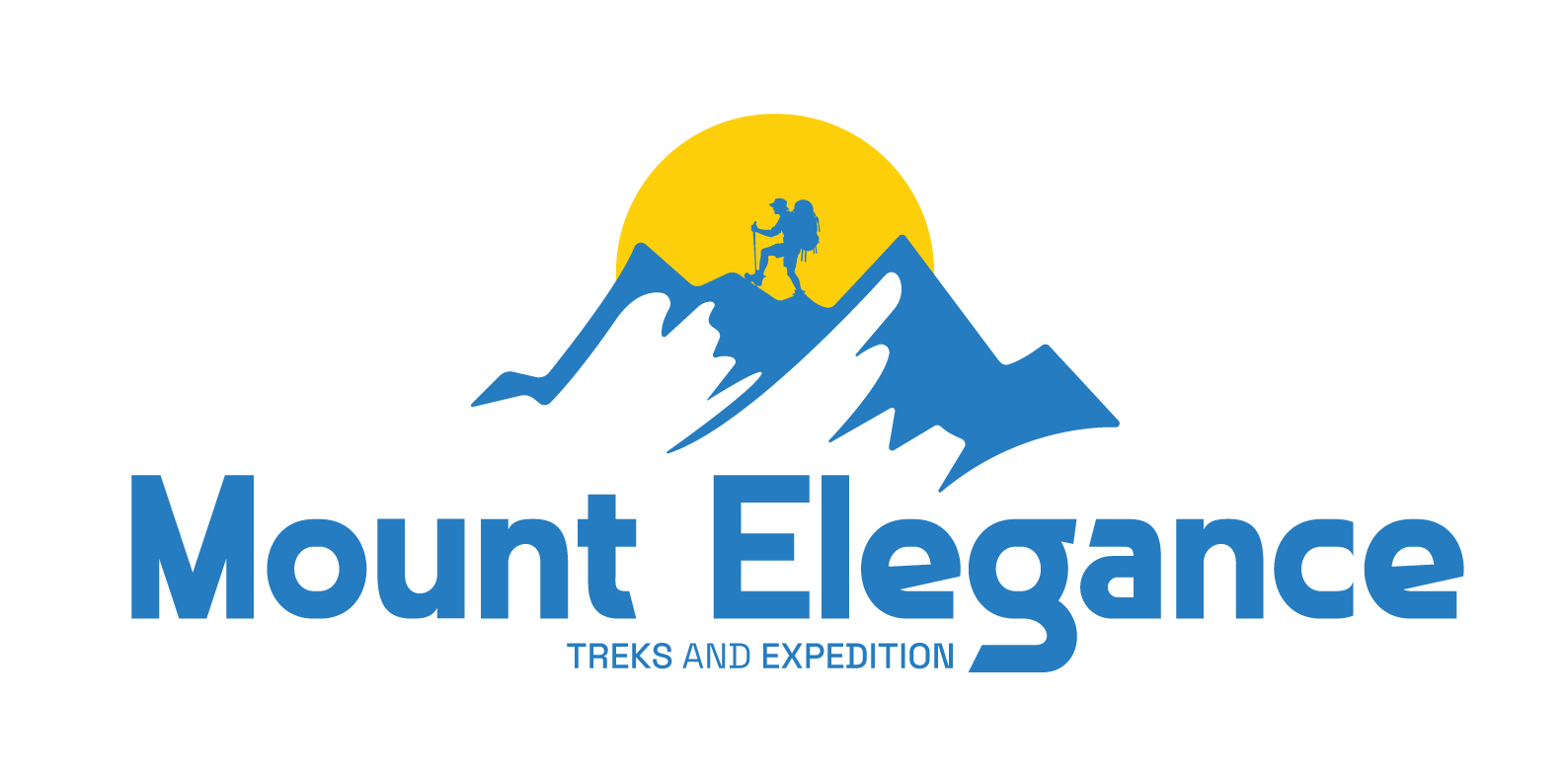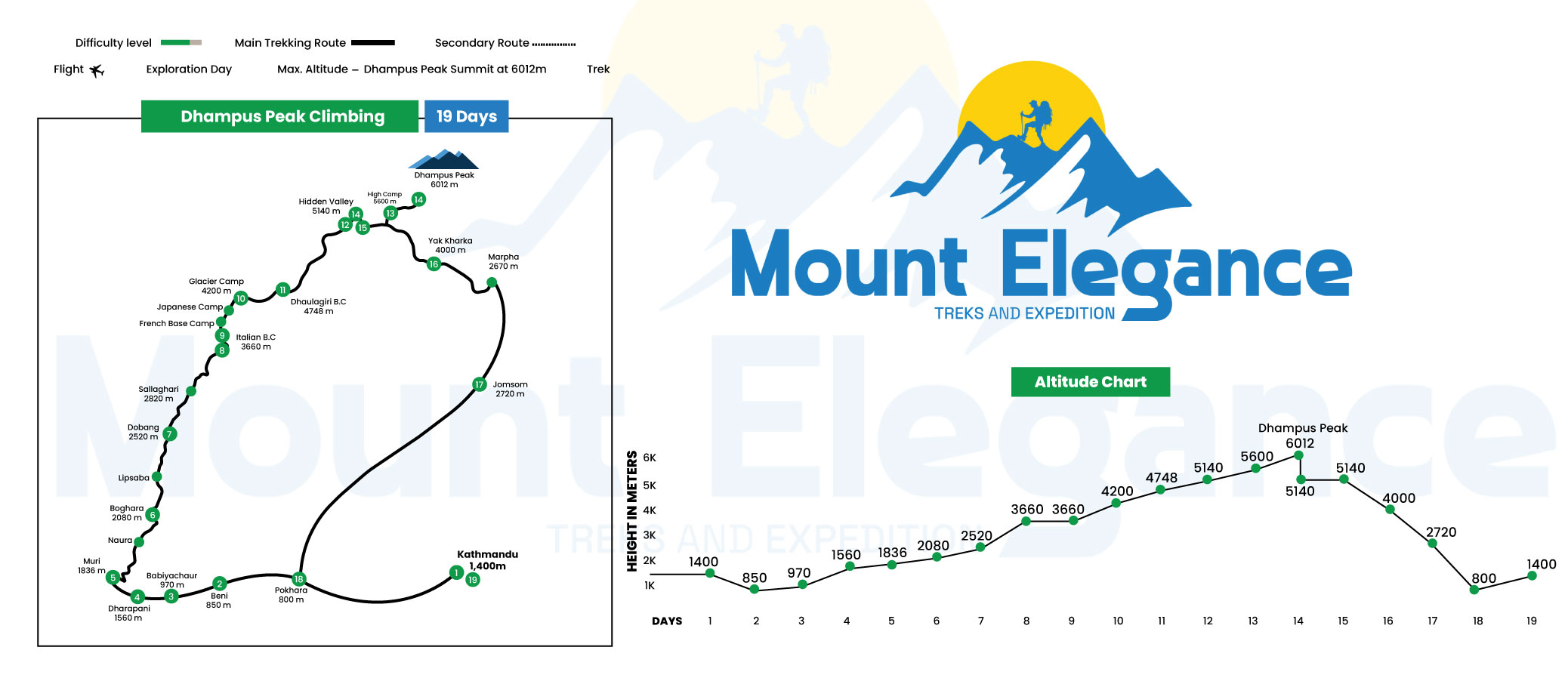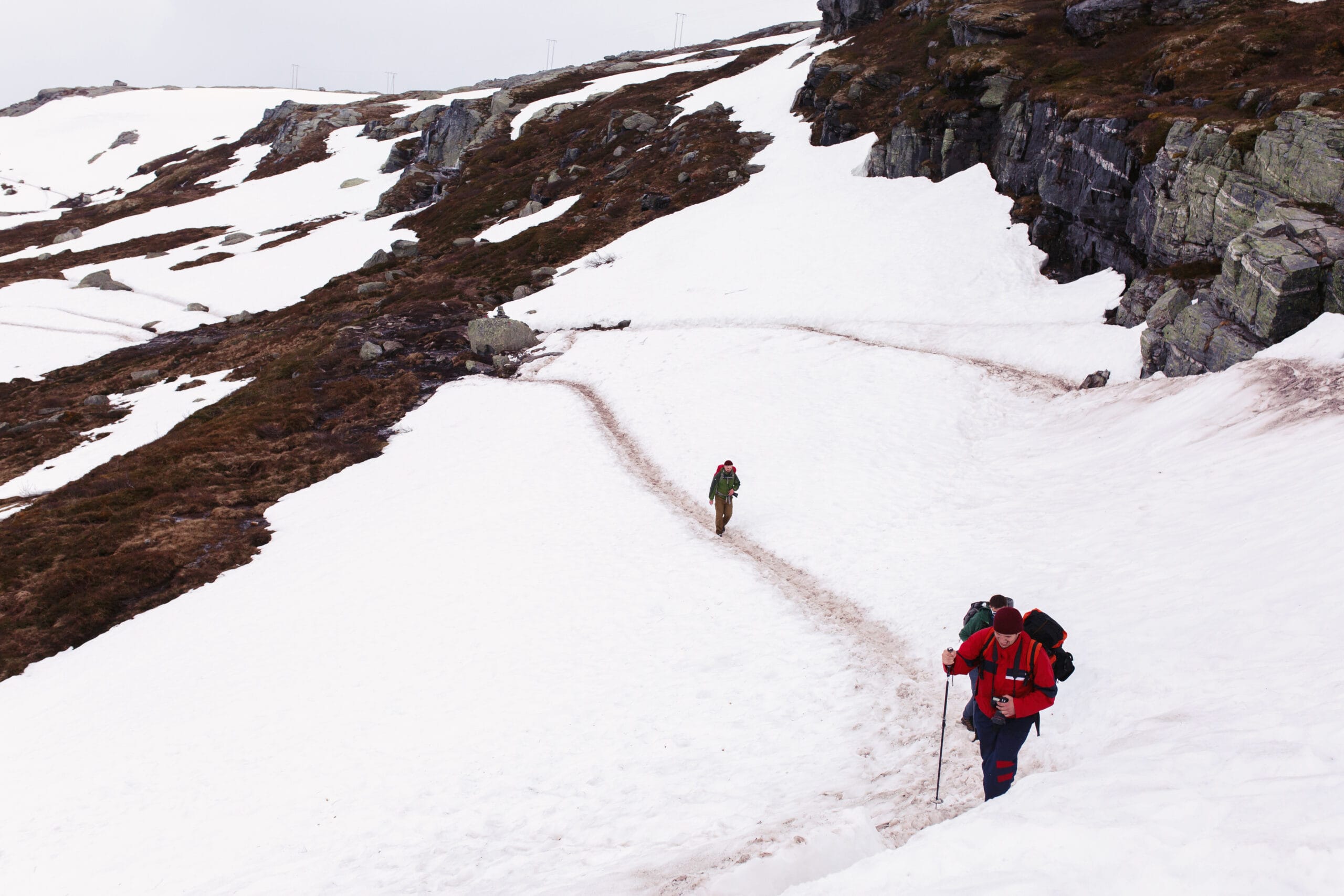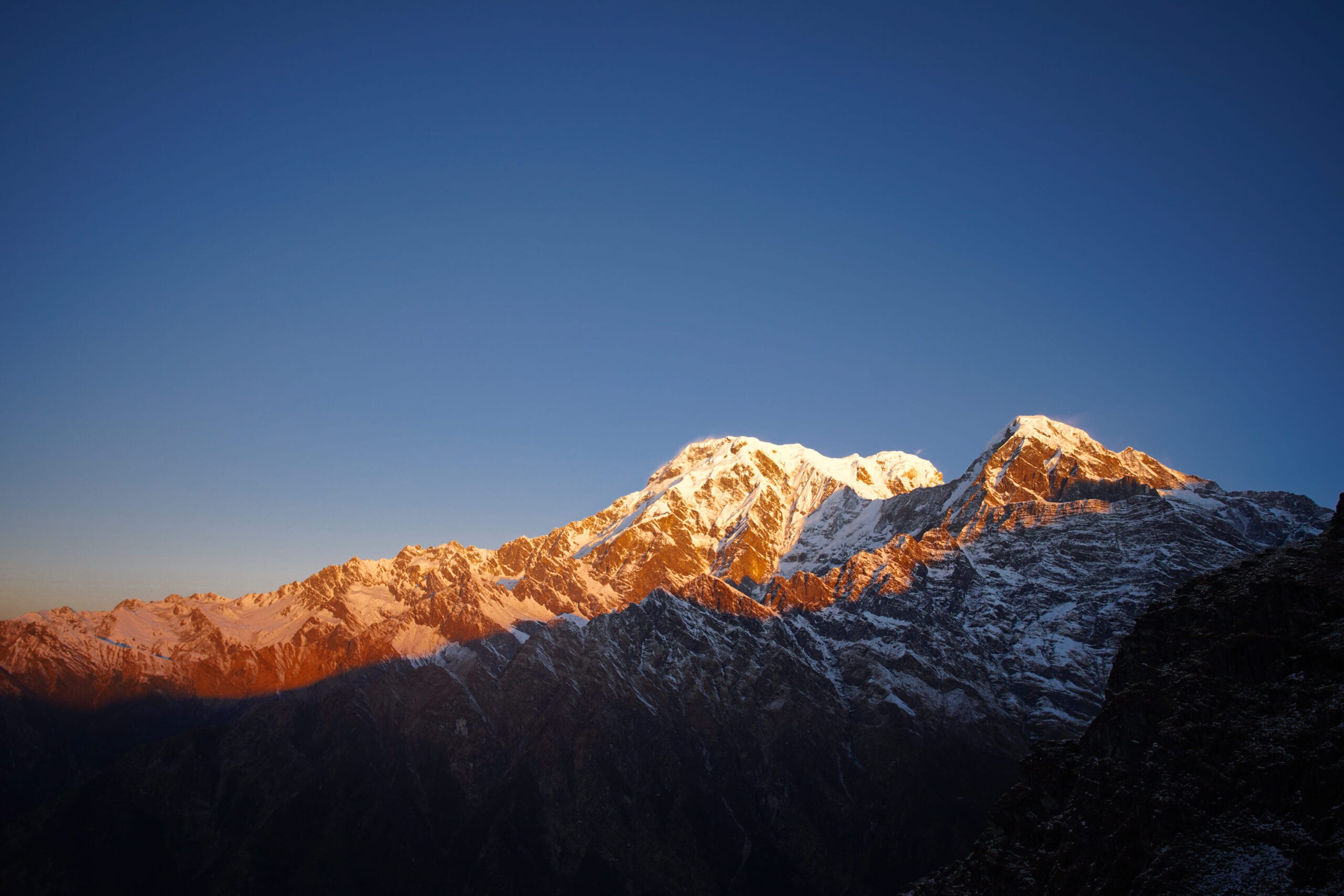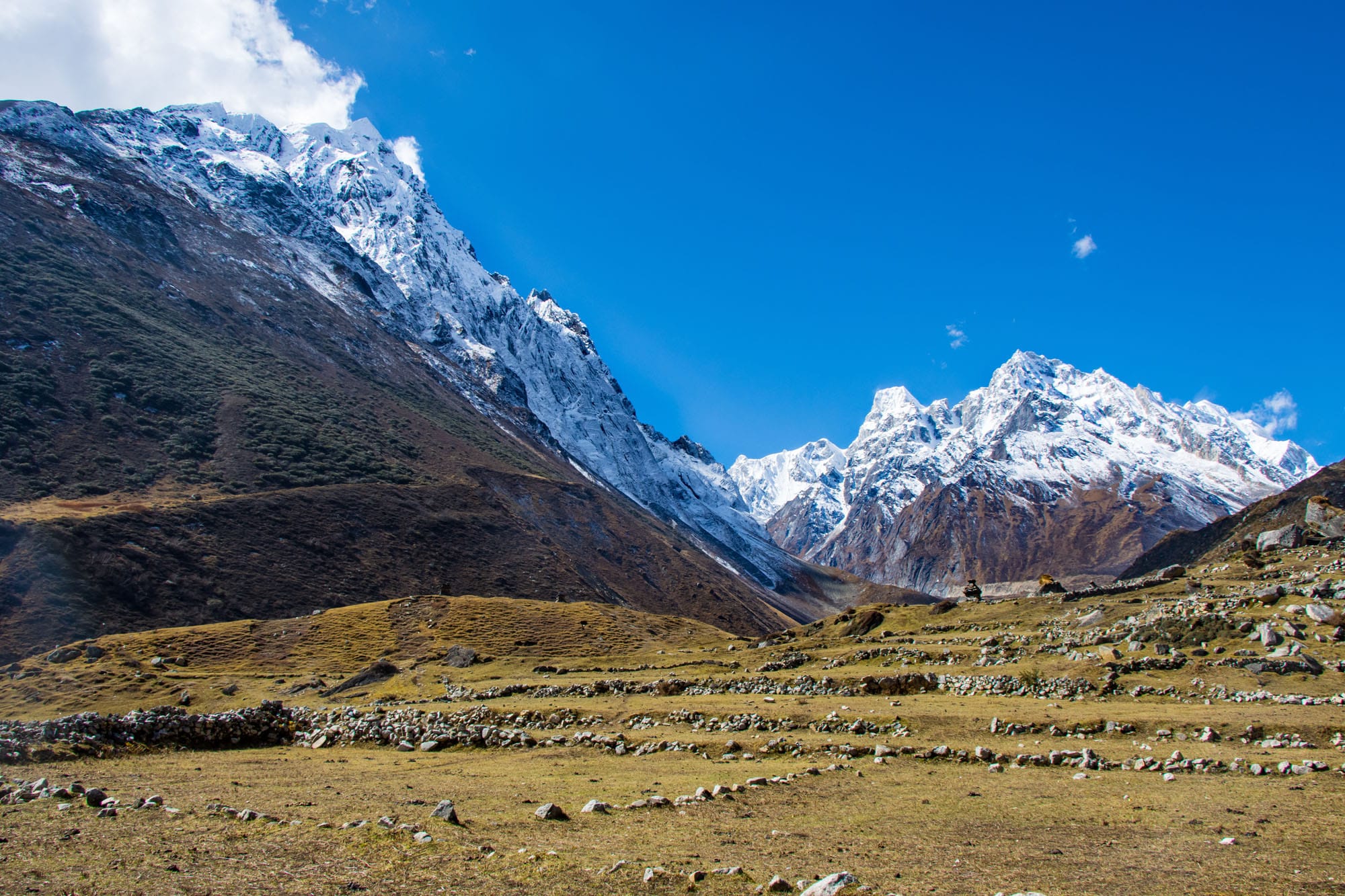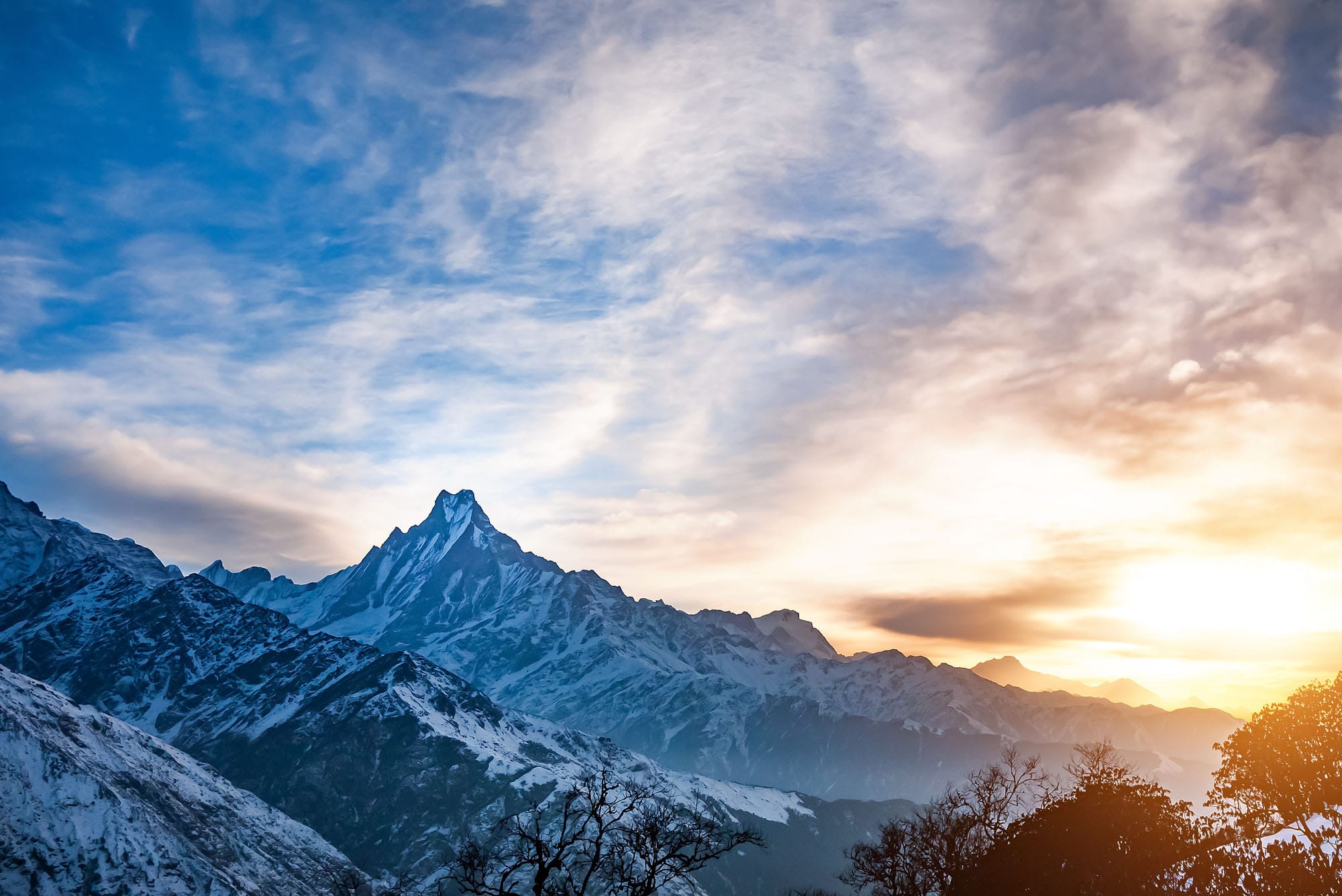Dhampus Peak Climbing – 19D
Best Season
Highest Altitude
Trip Overview
Dhampus Peak Climbing – 19 Days is a thrilling Himalayan expedition perfect for trekkers looking to step into the world of alpine mountaineering. Situated in the spectacular Dhaulagiri region of Nepal. Dhampus Peak Climbing – 19 days also known as Thapa Peak—offers an ideal non-technical summit experience with panoramic views of over 30 Himalayan giants. This Dhampus Peak Climbing – 19 days itinerary combines the adventure of the Dhaulagiri Circuit Trek with the challenge of a high-altitude peak ascent, making it one of the most scenic and rewarding peak climbing packages in Nepal.
Dhampus Peak Climbing – 19 days begins in the subtropical lowlands and gradually ascends through rhododendron forests, remote valleys, alpine pastures, and glacier terrain. During the Dhampus Peak Climbing – 19 Days route, you’ll explore highlights such as Dhaulagiri Base Camp, Italian Base Camp, and the rugged Hidden Valley, all while acclimatizing naturally before your summit push. The climb itself involves snow and ice sections, rope-assisted ascents, and stunning ridgeline views under the guidance of certified Sherpa climbing leaders.
Trip Highlights of Dhampus Peak Climbing – 19 days
- Summit Dhampus Peak Climbing – 19 days during a professionally guided Dhampus Peak Climbing – 19 Days adventure in Nepal.
- Follow the scenic Dhaulagiri Circuit route through forests, rivers, and high Himalayan passes like French Pass.
- Enjoy unmatched views of Dhaulagiri I, Tukuche Peak, Nilgiri, Annapurna, and other 6,000 to 8,000 m giants.
- Experience remote wilderness trekking as part of your Dhampus Peak Climbing – 19 Days itinerary.
- Camp in iconic locations like Italian Base Camp, Dhaulagiri Base Camp, and the windswept Hidden Valley.
- Receive hands-on climbing training at High Camp, including rope work and glacier travel skills.
- Complete the journey through Jomsom and Pokhara, adding cultural depth and a scenic conclusion to your climb.
Porter service (up to ~15 kg), WiFi and charging available in most lodges.
This trek offers not just a physical challenge but also a journey through one of the world’s most spectacular landscapes.
Essential Items:
- Base Layers: Thermal top and bottom
- Insulation: Fleece jacket and down jacket
- Outer Layer: Waterproof jacket and pants
- Trekking Clothes: Some pairs of trekking pants, quick-dry shirts
- Footwear: Trekking boots, camp shoes/sandals
- Headwear: Sun hat, warm hat, neck gaiter
- Hand-wear: Lightweight gloves, insulated gloves
- Accessories: Sunglasses, sunscreen, lip balm , headlamp with extra batteries , trekking poles ,50-60L backpack + daypack
- Personal Items: Hygiene essentials (toothbrush, toothpaste, wet wipes), Quick-dry towel ,Water bottle or hydration system (2L capacity), Snacks (energy bars, nuts)
- Medical Kit: Personal medications, basic first aid, altitude sickness pills
- Documents: Passport, trekking permits, travel insurance
- Optional: Camera, power bank, Lightweight sleeping bag
Refer to this for the full Equipment Checklist
Itinerary
Drive Duration: 30–45 minutes (airport transfer)
Meals: B
Highest Altitude: 1,400 m / 4,593 ft
Your Himalayan expedition begins with your arrival at Tribhuvan International Airport in Kathmandu, where a team representative will welcome you and transfer you to your hotel. After check-in, you can relax or explore Thamel’s vibrant streets and cultural shops.
In the evening, attend a detailed briefing about your Dhampus Peak Climbing – 19 Days itinerary and meet your guides. It’s a great time to address questions about gear, acclimatization, or logistics.
Drive Duration: ~9 hours - $190
Meals: B/L/D
Highest Altitude: 850 m / 2,789 ft
Today, you drive westward along winding highways, passing Trishuli and Marsyangdi rivers, terraced fields, and small towns toward the town of Beni, the starting point of the trek. The road conditions vary, but the dramatic scenery of the mid-hills keeps the journey engaging.
Beni, located at the confluence of the Kali Gandaki and Myagdi Khola, is a busy market town surrounded by green hills. You’ll rest here in preparation for your trekking adventure that begins the following day.
Trek Duration: ~5–6 hours
Meals: B/L/D
Highest Altitude: 970 m / 3,182 ft
Your trek begins as you follow the Myagdi River through charming villages and fertile farmlands. The trail is relatively easy today and allows your body to adjust gradually to the rhythm of daily trekking.
You’ll reach Babiyachaur, a peaceful riverside settlement surrounded by rice paddies and dense forests. This first trekking night introduces you to local village life and the slower pace of remote Nepal.
Trek Duration: ~6 hours
Meals: B/L/D
Highest Altitude: 1,560 m / 5,118 ft
The trail gradually ascends through villages like Shahashradhara and Ratodunga with views of waterfalls and forested hills. You begin to notice Buddhist influences as you move deeper.
Dharapani is a hillside village where the air is fresher and cooler. This marks a shift from lowland heat to alpine climate.
Trek Duration: ~5–6 hours
Meals: B/L/D
Highest Altitude: 1,850 m / 6,069 ft
Ascend gradually through terraced farms and rhododendron forests. Cross rivers via suspension bridges and enjoy the first glimpses of Dhaulagiri.
Muri is a culturally rich Magar village offering panoramic views and a warm welcome. You’ll get a feel of life in remote mountain communities.
Trek Duration: ~6–7 hours
Meals: B/L/D
Highest Altitude: 2,080 m / 6,824 ft
The trail descends steeply and then climbs again through deep gorges and bamboo forests. The terrain is rugged but scenic.
Boghara is a small, quiet settlement with limited facilities but rewarding solitude. This is the last permanent village on the trail.
Trek Duration: ~5–6 hours
Meals: B/L/D
Highest Altitude: 2,520 m / 8,268 ft
Follow forested trails with views of cliffs, waterfalls, and occasional wildlife. The environment becomes wilder and more remote.
Dobang is nestled in a forest clearing and marks your entry into high mountain wilderness. The Dhaulagiri massif starts to dominate the skyline.
Trek Duration: ~6 hours
Meals: B/L/D
Highest Altitude: 3,660 m / 12,008 ft
Climb steadily through alpine terrain, crossing the Myagdi Khola via bridges and narrow paths. The air gets thinner and the peaks closer.
Arrive at Italian Base Camp, with stunning views of Dhaulagiri II and IV. It’s a major acclimatization stop and one of the most beautiful campsites.
Trek Duration: Short hikes
Meals: B/L/D
Highest Altitude: 3,660 m / 12,008 ft
Rest and explore the surroundings to allow your body to adjust. A short hike above camp enhances acclimatization.
This day is crucial for safe altitude gain. Enjoy views, photograph glaciers, and prepare for the push into even more remote terrain.
Trek Duration: ~5–6 hours
Meals: B/L/D
Highest Altitude: 4,200 m / 13,780 ft
Today’s trail is challenging as you cross moraines and icy sections. Porters and guides assist with safety.
Glacier Camp lies on the moraine, surrounded by dramatic ice cliffs. It’s a raw and powerful environment at the foot of Dhaulagiri.
Trek Duration: ~6 hours
Meals: B/L/D
Highest Altitude: 4,740 m / 15,551 ft
Cross steep moraines and icy glaciers as the scenery turns surreal. Towering peaks and avalanches echo around you.
Dhaulagiri Base Camp offers up-close views of Dhaulagiri I (8,167 m). It’s a truly inspiring location to camp.
Trek Duration: ~7–8 hours
Meals: B/L/D
Highest Altitude: 5,360 m / 17,585 ft
Climb steeply to French Pass, the highest trekking point before the summit. Views are astonishing in all directions.
Descend into the rarely visited Hidden Valley, an expansive plateau surrounded by snow peaks. Camp here before summit prep.
Trek Duration: ~3–4 hours
Meals: B/L/D
Highest Altitude: 5,600 m / 18,372 ft
Ascend to High Camp via a snow-covered ridge. The trail is steep but short, designed for summit positioning.
High Camp is a minimalist, wind-exposed area with jaw-dropping views. Hydrate and rest early for tomorrow’s push.
Trek Duration: ~8–10 hours
Meals: B/L/D
Highest Altitude: 6,012 m / 19,724 ft
Summit day starts before dawn. You’ll use crampons and ropes to ascend snow slopes and icy ridgelines under Sherpa guidance.
From the top of Dhampus Peak, witness a 360° view of Annapurna, Dhaulagiri, and Mustang. Descend safely back to Hidden Valley.
Trek Duration: N/A
Meals: B/L/D
Highest Altitude: Based on camp
This day is reserved in case of bad weather or altitude issues during the summit push.
If unused, it's a bonus rest day to enjoy the solitude and beauty of the Himalayas.
Trek Duration: ~6–7 hours
Meals: B/L/D
Highest Altitude: 5,240 m / 17,192 ft
Cross Dhampus Pass, a high saddle offering superb views of Tukuche Peak and Mustang Valley. The trail is long but stunning.
Descend to Yak Kharka, a windy pastureland known for grazing animals. It’s your last night of true wilderness camping.
Trek Duration: ~6–7 hours
Meals: B/L/D
Highest Altitude: 3,800 m (en route)
Today, descend steeply through the arid Mustang region with dramatic changes in landscape. The trail merges with the Annapurna Circuit.
Arrive at Jomsom, a windy but well-developed town with lodges, shops, and an airstrip. Celebrate your success here!
Flight Duration: ~25 minutes
Meals: B
Highest Altitude: 2,720 m / 8,924 ft
Board a short scenic flight back to Pokhara, flying above deep valleys and Himalayan massifs.
Enjoy a relaxing day by the lakeside in Pokhara. Celebrate with a proper meal or boat ride on Phewa Lake.
Drive Duration: ~6–7 hours or 25-minute flight
Meals: B/D
Highest Altitude: 1,400 m / 4,593 ft
Return to Kathmandu by tourist bus or Jeep. Check in at your hotel and enjoy the final evening.
Reflect on your Dhampus Peak Climbing – 19 Days adventure, shop for souvenirs, or enjoy a farewell dinner with your team.
Book Now
Send an Inquiry
Got A Question?

Mr. Shishir Dhakal
Price Inclusion
- Airport transfers in Kathmandu, Drive from Kathmandu- beni in bus/jeep.
- Domestic flights (Pokhara–Jomsom) are included.
- Three meals a day (breakfast, lunch, dinner) during the trek and climb, along with tea or coffee, are fully covered.
- Accommodation in standard teahouses during the trek and tented camping at high-altitude camps is provided.
- Accommodation in (3-star Hotel) in Kathmandu and pokhara with breakfast.
- All necessary permits, including Dhampus Peak Climbing Permit, ACAP, and TIMS card, are arranged.
- Services of an experienced government-licensed trekking guide and a certified Sherpa climbing guide are included.
- Group mountaineering equipment such as fixed ropes, tents, ice screws, and first-aid kits are supplied.
- Seasonal fresh fruit as dessert every evening after dinner.
- Mount Elegance free Tshirt and Route map.
- Complimentary first aid box (Guide will carry during trekking).
- Oximeter to measure the Oxygen (For awareness of the high altitude sickness).
- Pre-climb training at High Camp and full support staff including porters and kitchen crew are part of the package.
- Duffel bag and sleeping bag for trekking (Should be returned after trek completion).
- One porter for two trekkers.
- Farewell dinner at the end of the trek.
- Certificate after trek completion.
Price Exclusion
- International flights to and from Nepal are not included in the trip cost.
- Nepal visa fees and travel insurance covering emergency evacuation are excluded.
- Meals and accommodation in Kathmandu after the trek are not covered.
- Personal climbing gear such as crampons, boots, and harnesses are not provided.
- Additional drinks (bottled water, soft drinks, alcohol), snacks, and desserts are at your own expense.
- Tips and gratuities for guides, porters, and climbing crew are not part of the package.
- Expenses due to delays, bad weather, landslides, illness, or itinerary changes are the client’s responsibility.
- Travel insurance for personal loss, injury, or illness.
Additional Information
Trip Map
Meals and Accommodation
The Everest Base Camp Trek offers an iconic trekking experience filled with breathtaking landscapes and cultural immersion. Accommodation and meal arrangements along the route are designed to provide comfort and sustenance throughout this journey.
Accommodations in Kathmandu and on the Trek
In Kathmandu, you’ll stay in a standard hotel equipped with modern amenities and complimentary WiFi to help you unwind and prepare for the trek.
Along the trail, you’ll stay in teahouses that provide cozy rooms with basic amenities, typically in shared or twin-sharing setups. Most teahouses feature communal dining areas where you can enjoy meals and connect with other trekkers. Facilities like hot showers, charging outlets, and WiFi are available at many lodges along the route, but extra charges may apply.
Meals on the Trek
Full-board meals, including breakfast, lunch, and dinner, are provided during the trek. The meals typically consist of a variety of healty options with Nepali, Tibetan, and international influences, such as dal bhat, noodles, and soups. Breakfast is included in Kathmandu, while you’ll have access to a range of local and international dining options in the city for other meals.
Best Season for Dhampus Peak Climbing
Spring (March to May)
- Weather: Mild temperatures, blooming rhododendrons, and clear skies.
- Temperature:
- Lower elevations (2,860m to 3,500m): 10°C to 20°C during the day, 0°C to 5°C at night.
- Higher elevations (up to 5,644m): -5°C to 10°C during the day, -15°C to -5°C at night.
- Highlights: Vibrant landscapes and moderate temperatures make this an excellent time to trek to Everest Base Camp and climb Kala Patthar.
Autumn (September to November)
- Weather: Stable, clear skies and comfortable temperatures.
- Temperature:
- Lower elevations (2,860m to 3,500m): 10°C to 20°C during the day, 0°C to 5°C at night.
- Higher elevations (up to 5,644m): -5°C to 10°C during the day, -15°C to -5°C at night.
- Highlights: Post-monsoon clarity offers spectacular views, making it a popular season for panoramic vistas of Everest.
Equipment Checklist
Trekking in Nepal is an incredible adventure, taking you through diverse landscapes, from lush forests to rugged mountain trails. To fully enjoy the experience, it’s crucial to pack the right equipment. Here’s an essential checklist to help you prepare for your trek, ensuring you’re ready for the challenges and beauty of the Himalayas.
1. Clothing
- Base Layers: Moisture-wicking base layers (thermal tops and bottoms) are essential for regulating your body temperature. Opt for lightweight, breathable materials.
- Mid Layers: Fleece jackets or lightweight down jackets provide warmth in colder temperatures. These layers should be easy to add or remove as needed.
- Outer Layers: A waterproof and windproof jacket is essential to protect against rain, wind, and snow. Make sure it’s breathable to stay comfortable during strenuous activities.
- Trekking Pants: Lightweight, quick-drying pants are ideal. Consider packing thermal pants for colder regions or seasons.
- Gloves, Hats, and Buffs: Warm gloves, a woolen hat, and a buff or neck gaiter help protect against the cold at high altitudes.
- Trekking Socks: High-quality, moisture-wicking socks (at least three pairs) are crucial to prevent blisters and keep your feet dry.
2. Footwear
- Trekking Boots: Sturdy, well-fitted, and waterproof trekking boots with good ankle support are essential. Break them in before your trek to avoid blisters.
- Sandals or Camp Shoes: Lightweight sandals or camp shoes for relaxing at tea houses or lodges after a long day of trekking.
3. Backpack and Storage
- Daypack (20-30 liters): A small, comfortable daypack with rain cover to carry essentials like water, snacks, camera, and extra layers.
- Duffel Bag (60-80 liters): For your main gear, use a durable, waterproof duffel bag that will be carried by porters.
- Dry Bags or Ziplock Bags: For protecting electronics, documents, and clothes from moisture.
4. Trekking Gear
- Trekking Poles: Adjustable trekking poles reduce the strain on your knees, especially during steep descents.
- Headlamp with Extra Batteries: Essential for early morning starts, late finishes, or use in lodges where electricity may be limited.
- Water Bottles and Purification: Carry reusable water bottles and purification tablets or a water filter to ensure safe drinking water.
- Sleeping Bag: A four-season sleeping bag rated for temperatures as low as -10°C to -15°C is recommended for high-altitude treks.
5. Health and First Aid
- Personal First Aid Kit: Include essentials like band-aids, antiseptic wipes, blister treatment, pain relievers, and any personal medications.
- Sunscreen and Lip Balm: High SPF sunscreen and lip balm are essential to protect against strong UV rays at high altitudes.
- Hand Sanitizer and Wet Wipes: Useful for maintaining hygiene when water is limited.
- Altitude Sickness Medication: Consult your doctor about medications like Diamox for preventing altitude sickness.
6. Personal Items and Extras
- Snacks and Energy Bars: Pack lightweight, high-energy snacks for a quick boost on the trail.
- Sunglasses with UV Protection: Essential for protecting your eyes from the intense sunlight and snow glare at high altitudes.
- Camera or Smartphone: To capture the breathtaking scenery. Don’t forget extra batteries or a portable charger.
- Personal Toiletries: Include biodegradable soap, toothbrush, toothpaste, and a small towel.
- Cash: Carry enough local currency for expenses along the trail, as ATMs are not available in remote areas.
7. Documents
- Passport and Visa: Carry your passport, visa, and photocopies in a waterproof pouch.
- Permits: Obtain trekking permits such as the TIMS card and national park or conservation area permits, depending on your route.
- Travel Insurance Details: Ensure you have comprehensive travel insurance covering high-altitude trekking, emergency evacuations, and medical expenses.
Final Tips
- Pack Light: Try to keep your backpack under 10-15 kg. The lighter your pack, the more enjoyable your trek will be.
- Layer Up: Layering is key for comfort in Nepal’s changing weather conditions. Bring versatile clothing that can be easily added or removed.
- Double-Check Your Gear: Before you set off, double-check that you have all the essentials. Missing a crucial item could make your trek less comfortable or even dangerous.
Frequently Asked Questions(FAQs)
Is it safe to trek alone in Nepal?
While trekking alone can be a liberating experience, we recommend that travelers consider the safety aspects of solo trekking in Nepal. The country has a well-trodden trekking infrastructure, with many established trails and tea houses, and most trekkers encounter no issues. However, as with any travel, especially in remote areas, there are risks involved. To minimize these risks, it’s essential to plan thoroughly, research your route, and let someone know your itinerary. At Mount Elegance Treks and Expedition, we offer guided trek options and can also provide advice on solo trekking. If you do choose to trek alone, make sure to stay informed, be prepared, and take necessary precautions to ensure a safe and enjoyable journey.
How do I travel from Kathmandu to Pokhara?
Traveling from Kathmandu to Pokhara is relatively easy, with several options to suit your budget and preferences. Our team at Mount Elegance Treks and Expedition recommends the following:
Flights: Take a scenic 25-minute flight from Tribhuvan International Airport (KTM) to Pokhara Regional Airport (PKR). This is the quickest way to reach Pokhara, with multiple daily flights available.
Bus: Take a tourist bus or a local bus from Kathmandu’s Talachok Bus Park or Thamel Bus Park to Pokhara Bus Station. The journey takes around 6-7 hours, depending on traffic and road conditions.
Private Car and Driver: Hire a private car and driver for a door-to-door service, which takes around 6-7 hours, depending on traffic and road conditions.
Tourist Coach: Join a guided tourist coach, which departs from Kathmandu’s tourist hub, Thamel, and takes around 6-7 hours to reach Pokhara.
Regardless of the mode of transportation, our team can assist you with booking and arrangements, ensuring a smooth and comfortable journey. We can also provide recommendations on the best time to travel, road conditions, and any necessary documentation.
What is the difference between a guide and a porter?
While both guides and porters play essential roles in supporting trekkers in Nepal, their responsibilities and duties differ. A porter is responsible for carrying your luggage and gear, allowing you to focus on enjoying the trek. Porters are hired to assist with the physical demands of carrying loads, and they typically carry 20-30 kilograms of luggage per day. On the other hand, a guide is trained to lead and assist trekkers with navigation, cultural insights, and emergency response. Guides are responsible for ensuring your safety, providing information about the route, and handling any unforeseen situations that may arise during the trek. At Mount Elegance Treks and Expedition, we offer both guide and porter services, and we carefully select and train our staff to ensure that you receive the best possible support and attention during your Nepal trek. By hiring a guide and porter, you can enjoy a hassle-free and unforgettable trekking experience.
How much does a porter cost for Nepal treks?
The cost of a porter for Nepal treks varies depending on the duration and difficulty of the trek, as well as the number of porters required. On average, the cost of a porter for a day is around $20-25, while a full-time porter for a multi-day trek can range from $300-500 or more, depending on the length and difficulty of the trek. At Mount Elegance Treks and Expedition, we offer porter services as part of our trek packages, and the cost is included in the overall package price. Our porters are experienced, trained, and insured, and we ensure that they are treated fairly and with respect. We also offer the option to hire additional porters or have a personal porter for an added fee, which can be tailored to your specific needs and budget. Please contact us for a customized quote for your Nepal trek.
Is the drinking water safe on Nepal treks?
While tap water in Nepal is not considered safe for drinking, there are plenty of alternatives to stay hydrated during your trek. Most teahouses and lodges provide boiled, filtered, or bottled water, which is safe to drink. Our guides will also be happy to assist you in finding safe drinking water sources, and we recommend bringing a water purification tablet or filter as an added precaution. Additionally, many trekkers opt to drink tea or coffee, which are also widely available and made with safe water. At Mount Elegance Treks and Expedition, we prioritize your health and safety, and our guides will ensure that you have access to safe drinking water throughout your trek, so you can focus on enjoying the stunning scenery and cultural experiences.
What food is available during treks in Nepal?
During treks in Nepal, you can expect to find a variety of traditional Nepalese cuisine, as well as international options, at teahouses and lodges along the trail. Local dishes such as dal bhat (lentil soup and rice), momos (Tibetan-style dumplings), and gorkhali lamb (curried lamb) are staples, while tea, coffee, and fresh juice are also widely available. Many teahouses also offer Western-style options, including pasta, sandwiches, and soups. For trekkers with specific dietary needs, it’s best to inform your guide in advance, and they can assist with arranging meals that cater to your requirements. At Mount Elegance Treks and Expedition, we can provide guidance on what to expect in terms of food options and ensure that you’re well-nourished throughout your trek, allowing you to focus on enjoying the stunning scenery and cultural experiences.
What are teahouses and what facilities do they offer?
Teahouses are simple lodges that provide accommodation and basic amenities to trekkers in the mountains of Nepal. These family-run establishments offer a unique and authentic experience, allowing you to immerse yourself in the local culture. Teahouses typically provide dormitory-style rooms, private rooms, and shared bathrooms, as well as a restaurant serving traditional Nepalese cuisine and a cozy common area. Facilities may also include hot showers, laundry services, and internet access. While teahouses are basic, they offer a warm and welcoming atmosphere, and our experienced guides can help you navigate the teahouse system and ensure a comfortable stay. At Mount Elegance Treks and Expedition, we work closely with teahouse owners to ensure that our clients receive the best possible service and enjoy a memorable stay in the mountains.
Where can I rent trekking equipment in Kathmandu?
Kathmandu offers a wide range of shops and outlets where you can rent trekking equipment, including hiking boots, trekking poles, sleeping bags, and jackets. Some of the most reputable rental shops include Kathmandu Trekking Stores, Himalayan Adventure Rentals, and Nepal Trekking Store. These shops offer high-quality equipment at reasonable prices, and many also provide rental guidance and advice to ensure you get the right gear for your trek. At Mount Elegance Treks and Expedition, we can provide you with a list of recommended rental shops and help you navigate the process, so you can focus on preparing for your adventure. Our team is also happy to assist with gear fitting and ensure you’re properly equipped for a safe and enjoyable trek.
What fitness level is required for trekking in Nepal?
Trekking in Nepal can be suitably adapted to various fitness levels, but it’s essential to be moderately fit to enjoy the journey. Our treks range from easy to challenging, with most itineraries involving 4-6 hours of walking per day. While some physical exertion is required, the scenic beauty and gradual ascents make it accessible to many. If you have any health concerns or doubts, we recommend consulting with your doctor before booking. At Mount Elegance Treks and Expedition, we also offer customized trek options and can provide guidance on preparing for your trek, ensuring a memorable and enjoyable experience in the Nepalese Himalayas.
How much does a taxi cost in Kathmandu?
The cost of a taxi in Kathmandu varies depending on the distance, traffic, and type of taxi. Our team at Mount Elegance Treks and Expedition provides the following estimated fares as a general guideline:
Metered Taxi: The fare starts from NPR 200 (approximately USD 1.80) and increases by NPR 10-15 (approximately USD 0.09) per kilometer.
Non-Metered Taxi: The fare is usually negotiated at the start of the journey, with prices ranging from NPR 500-1,000 (approximately USD 4.50-9) for short distances.
Tourist Taxi: These taxis are specifically designed for tourists and have fixed rates, ranging from NPR 1,000-2,000 (approximately USD 9-18) for a one-way journey.
To avoid any confusion, we recommend:
Using a metered taxi for a fair and transparent fare.
Agreeing on the fare before starting your journey with a non-metered taxi.
Asking your hotel or tour operator for recommendations on reliable taxi services.
Our team can also arrange for a private car and driver for the day, which can be a convenient and hassle-free option. We’ll be happy to provide more information and assistance with your transportation needs in Kathmandu.
Experiences That Last a Lifetime
Verified Fantastic Annapurna Base Camp Trek Everything was perfectly organized, down to the last detail. Everything ran smoothly and was very well planned. The care and company were absolutely lovely 🙂 it was amazing time. 9 days of trekking with breathtaking views, delicious food along the way, and amazing guides.On top of that, I ended up in the hospital because of appendicitis, and I was never alone — the organizers surrounded me with exceptional care. Thank you Shishir 🙏🏻Verified Very amazing. Very beautiful places. Breathtaking views and the guide @ Mr. Santosh, very nice and amazing talent.The food and culture was purely loss of words to us. Thank you.Verified Najpiękniejsze góry świata, cudowny magiczny czas. Wspaniale doświadczenie, doskonała organizacja, przemili przewodnicy i porterzy, zawsze gotowi pomóc i wesprzeć radą. Wyprawa którą na zawsze pozostanie w moim sercu.Doznania których nie sposób doświadczyć nie biorąc udziału w tej wyprawie. Z pewnością polecę udział w tej przygodzie moim przyjaciołom.Verified Annapurna circuit, Nar Poo trek, Mardi himal, etc This company manages the entire process very responsibly and leads the contract in detail, very kindly and reliably. Finally all costs are more reasonable than other companiesVerified Mr tourism "I had an incredible experience with Mouth elegance during my Mr. Tourism journey! Their professionalism, expert guidance, and warm hospitality made every trek seamless and unforgettable. Highly recommended for anyone looking to explore Nepal’s breathtaking landscapes!"Verified Annapurna Rounding/Punhill.abc Dream-like sea trip February 13 Annapurna Rounding/Punhill.abcTrekkingMeeting with the president and guide Ray at Tammel Hotel...Knowing everything about travel Thank you for moving forward...I was able to leave the trekking. Thank you.Without completing a journey of 20 days With the hard work of well-led Ray GaidenWe had a comfortable and enjoyable trip.Thank you for the careful care of the local travel agent.I wish to visit again next time.We wish the unlimited development of the travel company.Verified The most wonderful and satisying Trek with the best team b I had the most amazing trip. I had been to Poonhill trek ! Thanks to Mr Shishir Dhakal, and Mount Elegance, such a supportive guy ! Without your help, i may not have such good trip ! my best memory of life !
